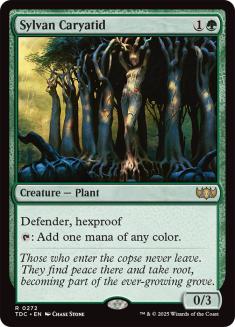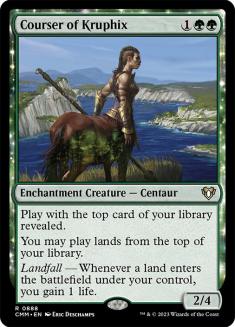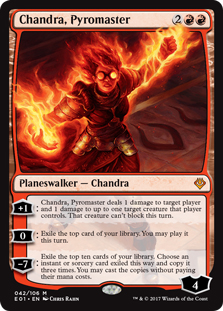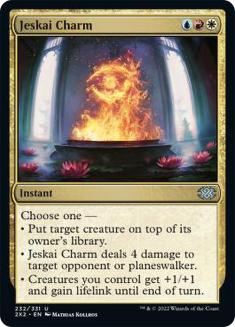The new World Championship tournament is a wildly different thing than the previous World Championship event. The new event, for the most part, looks like
a modified “All-Star” tournament, and the old event, for the most part, looked like an extra Pro Tour (albeit one with even more pageantry). While I’m
still not certain I don’t prefer the old format, the one thing that is true is that every round, you feel like you are seeing a clash of the titans.
It is only sometimes that I try not to have a horse in the race, and this is not one of those times. I’m rooting for Patrick Chapin, and I’m
excited for him to have the chance to finally get this title he’s wanted for so long. It was also really exciting to have had two players from Wisconsin,
Sam Black from Madison and Owen Turtenwald from Milwaukee, there representing things for the Badger State. For them (even though I am pretty sure neither
of them are fans), I was definitely feeling this:

On Wisconsin!
They both ended up right near the middle of the pack. Of course, that is the middle of a pretty incredible pack, but still.
One of the interesting things about such a small event is that players even begin to plan for each other. Tom Martell put it really well, in this article on the Wizards mothership: “It’s a bizarre kind of chess match.
Everyone is trying to out-think the field.” While we can’t really know how that ended up influencing one decision or another, one thing we can do
is look at the decks that did well in the two Constructed segments of the game, one Standard, one Modern, and see if there are any lessons to be learned.
A quick glance at combined Constructed records yields two interesting results. First, only Yuuya Wanatabe had winning records in both Standard and
Modern. I think this says a lot about how difficult it is to select decks that give you an edge over this elite a group of players. For example, with one
of my decks, I tend to say “Oh, I’ll lose to Temur, but only if they know what they’re doing.”–this is a group that largely will likely know what
they’re doing. As such, some of the results seem likely to be more accurate to the nature of the archetype’s performances. Second, only a small handful of
players had a winning record in one format and at least 50/50 in another: Yuuya (of course), Patrick Chapin, Ivan Floch, Paul Rietzl, Lars Dam,
Josh Utter-Leyton, and Tom Martell. Of these, Paul Rietzl joined Chapin in matching decklists, as did Josh Utter-Leyton and Tom Martell. This might
indicate a real advantage to working together in groups, though that result is somewhat marred when you look at the Channel Fireball Prime group at large,
which altogether had five people playing the same decks to very mixed results, and that Floch’s partner, Stanislav Cifka, had largely an opposite result.
I’m going to look at each format in turn, starting with the format I know much more intimately right now, Standard.
Standard at Worlds
Here are the average number of wins, per archetype, per player, for the four matches:
B/G Constellation: 2.67
Abzan Midrange: 2.6
Median Result: 2
U/B Control: 1.50
Mono-Red: 1.5
Sultai Reanimator: 1.39
This speaks well for midrange strategies just to start out. But, let’s look at the very bottom of the Standard field for a moment:
Stanislav Cifka, U/B Control, 1
Willy Edel, Sultai Reanimator, 1
Raphael Levy, Mono-Red, 1
Lee Shi Tian, Jeskai Ascendancy Combo, 1
Jacob Wilson, Abzan Midrange, 1
Paulo Vitor Damo da Rosa, Sultai Reanimator, 0
This certainly seems to reinforce notions of what isn’t working out. Sultai Reanimator, at least as chosen by the Channel Fireball crew, seems to have been
a bad call. Let’s look at the top of the field for a much clearer picture:
Reid Duke, B/G Constellation, 4
Shaun McLaren, Abzan Midrange, 4
Yuuya Watanabe, Jeskai Token Combo, 3.3
Paul Rietzl, Abzan Midrange, 3
Raymond Perez Jr., Abzan Midrange, 3
So, Yuuya ended Standard undefeated in the format by drawing with Kentaro Yamamoto, and other than that, every deck that had three wins or better
was making use of this:
I heard a rumor that Yuuya kept a full set of each of these cards in his wallet during the event, just for luck.
So what do these builds look like? Let’s take the very top of them with this undefeated deck:
Creatures (12)
Planeswalkers (6)
Lands (25)
Spells (17)

There is midrange and then there is midrange-control. Shaun’s deck is firmly in a more controlling stance, going so far as to run Read the Bones
and Duneblast. His deck is basically all card advantage, mana, answers, and lifegain, typically managing to pull off several of these modes at once. Only
Nissa, Worldwaker feels like it breaks that mold, since the “mana” ability of Nissa (untapping four Forest) seems so unlikely.
If you imagine this deck going toe-to-toe with another midrange deck, you can see why I might call this deck midrange-control. The plan here is to go over
the top. More card draw, minimal attention to holding the game against an aggressive deck, and a ton of answers, none of which can suddenly “unanswer” (I’m
looking at you, Banishing Light). McLaren’s sideboard acknowledges aggressive decks by bringing in a slew of cards: potentially 4 Drown in Sorrow, 2 End
Hostilities, a Bile Blight, and Ulcerate, but generally it appears that this is a deck gunning for a long game.
One interesting element to the mana of the deck is the full set of black Temples: 4 Temple of Malady and 4 Temple of Silence. These cut into Sandsteppe
Citadel ever so slightly for eleven enters-the-battlefield-tapped lands. I’ve been of the opinion that one of the best starting places for mana is with the
full four tri-lands. Take this list of Steve Rubin’s (the mastermind primarily responsible for the Ari Lax winning Abzan Midrange deck from Pro Tour
Honolulu):
Creatures (16)
Planeswalkers (6)
Lands (25)
Spells (13)

The constraints are a bit different here, since Steve’s deck is trying to cast Brimaz, King of Oreskos as well as Courser of Kruphix and
Thoughtseize/Hero’s Downfall early. Even so, I wonder if, with less early mana needs, if Shaun is onto something. I’ll definitely be trying to check out
slightly less tri-land configurations in builds that aren’t pushing their mana needs.
Shifting over, Reid Duke took B/G Constellation to a 4-0 record. Here is his list:
Creatures (26)
- 3 Hornet Queen
- 2 Elvish Mystic
- 4 Sylvan Caryatid
- 4 Courser of Kruphix
- 4 Satyr Wayfinder
- 4 Eidolon of Blossoms
- 3 Doomwake Giant
- 2 Pharika, God of Affliction
Lands (22)
Spells (12)

This looks to be an update of The Pantheon deck from Honolulu, removing a ton of mana acceleration and See the Unwritten for stable mana and more copies of
the game-breaking Hornet Queen and Eidolon of Blossoms. In addition, Whip of Erebos and Murderous Cut enter the deck.
I think what has been done here is a Pro Tour deck has been shifted into an Open format deck. At the Pro Tour, everyone is often walking into the format
somewhat blindly, and people don’t know exactly what they have to be worried about. In a format like that, it actually makes more sense to decide to go
wild with a ton of non-land mana to power out a See the Unwritten. The raw power of a decision like that is more likely to be rewarded.
However, now that the format is more discovered, we begin to expect that any black deck (which includes one of the most popular decks, Abzan
Midrange) is very likely to have a full set of Drown in Sorrow as well as copious amounts of other disruption for your plan. As built, Reid’s Worlds deck
is less explosive, but has a ton more staying power because of Eidolon of Blossoms and Whip of Erebos. It still has the ability to have an absurd turn,
thanks to Nykthos, Shrine to Nyx, but it isn’t relying on an absurd turn.
For an Abzan deck, fighting this kind of approach can be very difficult. Your opponent has cards that can be difficult to answer, and they might just run
away with the game. Even powerful plays like Elspeth, Sun’s Champion can find themselves overwhelmed by Giants and Hornets and Gods (and Flower), oh my!
In some sense, I think that this deck was an excellent choice as “the answer” for what might be popular. It appears to have been a good choice, since Abzan
was one of the two most popular strategies, with six players on some version of the archetype; Sultai Reanimator decks were the next most popular, though
they resoundingly fell flat.
Finally, we come to the last undefeated Standard deck, Yuuya Watanabe, with what is now probably the highest profile iteration of Jeskai Tokens Combo we’ve
seen. This deck went 3-0-1.
Creatures (8)
Planeswalkers (2)
Lands (24)
Spells (26)

Yuuya’s take on this deck looks pretty beautiful to me. Now, I’ve never been one who subscribed to the idea
that lots of four-ofs was the sign of a good deck, but I do appreciate a deck that looks like it runs lots of the right
four-ofs. This is that kind of deck.
First of all, looking at the mana, I appreciate how much care it looks like has been taking in making the mana feel correct. I’ve seen a lot of 2 Islands/2
Plains lists in these decks that aren’t running Dig Through Time, and it always feels like a mistake to me. 1 Island looks like the proper amount,
as does a full set of Mystic Monastery. This deck isn’t like Abzan, where maybe the Abzan deck can get away with one less tri-land since they have
extra fixing from Sylvan Caryatid and they aren’t typically looking for turn 3 XAB colors. This deck, however, does hope to drop Jeskai Ascendancy
into play as soon as possible. Not running the full four copies of Mystic Monastery would be a mistake, albeit one I see all the time.
Every other four-of feels incredibly appropriate. Four of each of the best token generators, four of the cards that best help guarantee pressure and
finishing the game out (the Seeker, Strike, Stoke), and then four Treasure Cruise instead of Dig through Time, acknowledging that you are just hoping to
end the game. Then you have this:
To me, this block of four cards is just a really smart choice. Chandra can help guarantee a steady stream of gas when the game has continued on, and Jeskai
Charm can give a little extra damage (in two of its modes), but is often more cumbersome to cast. Sometimes, it gives an explosive amount of damage.
Yuuya’s build has a small number of these to add some consistency via redundancy and card draw, but it isn’t viewing that it needs these things at all
times.
This is a great maindeck, but I also love that his sideboard can allow the deck to somewhat transform into a much more controlling deck. In some
situations, you can find yourself making these kinds of transformations even though you might not want to be that kind of deck game 1. I know I’ve had
decks where I wouldn’t want to be a control deck game 1 against an opponent, but their board plan makes me want to be one in game 2. I’m very
curious to see how this deck performs in the Top 4 of Worlds, since it is such an outlier.
Modern
Here are the average number of wins, per archetype, per player, for the four matches:
Jeskai Acendancy: 2.75
Temur Delver: 2.67
U/R Delver: 2.5
Burn: 2
Pyromancer Ascension: 1.67
Birthing Pod: 1.67
Jeskai Delver: 1.5
Scapeshift: 0.67
Unlike Standard, there were a lot more archetypes that were played, but only a couple that sat near the top. Again though, let’s start at the
bottom of Modern:
Jeremy Dezani , Scapeshift, 1
Raphael Levy, Scapeshift, 1
Shaun McLaren, Jeskai Control, 1
Jacob Wilson, Birthing Pod, 1
Reid Duke, Pyromancer Ascension, 1
Lee Shi Tian, Scapeshift, 0
Stanislav Cifka, Jeskai Delver, 0
It’s not all combo at the bottom, but there certainly is some of that down there. The top also has combo, so solitaire players need not weep:
Patrick Chapin , U/R Delver, 4
Kentaro Yamamoto, Temur Delver, 3
Yuuya Watanabe, Temur Delver, 3
Josh Utter-Leyton, Jeskai Ascendancy, 3
Tom Martell, Jeskai Ascendancy, 3
Ivan Floch, Jeskai Delver, 3
Lars Dam, Jeskai Ascendancy, 3
It looks like Modern might just be “All Delver, All Ascendancy, All Day.” At least Josh Utter-Leyton and Tom Martell only have one Treasure
Cruise, compared to the four of all of the other decks with blue in the top portion of the field. I’m going to examine four of these decks, Chapin’s 4-0
deck, Yuuya’s choice, and then Josh Utter-Leyton’s Ascendancy, and Willy Edel’s Abzan Midrange. Since I’ve spent very little time on Modern lately, I’m
going to reflect less about each deck, and more about what they say to me about Modern.
We’ll start with Chapin’s 4-0 deck.
Creatures (13)
Lands (18)
Spells (29)

I really like this list. Thought Scour is a card that I feel like is coming too late to the party in Modern, and Chapin is certainly not a player I’d
imagine missing it. Given that it is Chapin, I’m sure he’ll write an incredible and detailed accounting of this list. I’d just like to say that I think the
singleton Snapcaster Mage is an inspired choice; this deck fights Snapcaster Mage all on its own because of Treasure Cruise, and yet the card is still
powerful enough, especially in a Thought Scour deck, to warrant it. I’m sure Chapin tested a lot to come to that conclusion, and I’m certainly impressed by
the decision, as well as the other singletons. Kudos.
This is Yuuya’s 3-1 build:
Creatures (13)
Lands (18)
Spells (29)

One of the things I find very intriguing about this list and Chapin’s list are the specific numbers that they have exactly in common:
If we add to it the cards that are close in counts, we begin to paint a picture of a skeleton of a deck that is almost pre-built for us:
3/4 Gitaxian Probe
3/2 Spell Snare
2/1 Remand
The real incentives for green are Tarmogoyf and Ancient Grudge, though perhaps we’ll someday find out if sideboarded Savage Knuckleblade is worth it.
Josh Utter-Leyton was also 3-1:
Creatures (4)
Lands (22)
Spells (34)

So earlier, when I mentioned that this deck had “only” one copy of Treasure Cruise, what I left out was that it had four copies of Dig Through Time.
Reflecting on this deck running a 4/1 split and the two above Delver decks running a 4/1 split, I wonder if this is decent evidence that these decks can
actually support room for about five graveyard-eating cards before they overextended their use of the grave? I suppose we’ll see.
Taken together, the three above decks have something interesting to tell us about mana curves in Modern Delve decks (Delve not Delver). Each X below,
represents a card:
Chapin (18 lands)
One – XXXXXXXXXXXXXXXXXXXXXXXXXXXXXXXXXXX (35)
Two – XXXXXXX (7)
Three – XX (2)
Watanabe (18 lands)
One – XXXXXXXXXXXXXXXXXXXXXXXXXXXXXXXXXXX (35)
Two – XXXXXX (6)
Three – X (1)
Josh Utter-Leyton (22 lands)
One – XXXXXXXXXXXXXXXXXXXXXXX (23)
Two – XXXXXXXXXXX (11)
Three – XXXX (4)
Note: I’m counting Snapcaster as a “3”, delve cards as “1” or “2” depending, and Fatestitcher as a “1”.
These are pretty overwhelmingly low-heavy curves, as is necessary for a deck planning on exploiting delve as a mechanic. One of the things I find very
smart about Josh Utter-Leyton’s list is the inclusion of 4 Faerie Conclave in his 22 lands; not only does it make the heavier land count be not so costly,
but it also means he can kill with a flier as he is winning.
And now for the only non-Delving deck in the top of the field, Willy Edel at 3-1:
Creatures (14)
Planeswalkers (4)
Lands (24)
Spells (18)

This is basically a very classic deck, practically out of another time. Siege Rhino is the only Khans of Tarkir card in the full 75, which speaks pretty
intensely of its power given the cards it is next to.
One of the most interesting things about this list is the total exclusion of Dark Confidant. Liliana of the Veil is at its best when it is joined by
Confidant, and Willy, no stranger to midrange in Modern, totally eschewed the card. Against Delver decks, Dark Confidant is just too much of a liability.
Instead we see a full set of both Tarmogoyf and Scavenging Ooze. This actually seems like a great idea, since Tarmogoyf can be both a huge defender and a
huge clock, and Scavenging Ooze could go a long way to making other people’s attempts to delve feel fruitless.
The intense amount of discard is shocking to me in a Treasure Cruise format; I’d imagine that it would mostly go to waste. Still, he beat Yuuya, Raphael
Levy with Scapeshift, and split with Pod, beating Ray Perez and losing to Sam Black. With only one actual Treasure Cruise opponent (and one Dig Through
Time opponent), there isn’t much to go on about whether this plan can work, but maybe it can. I still remain a bit dubious though.
I think there were a lot of things that can be learned from the top play we have access to seeing at Worlds. Modern feels like it has been basically shoved
into the grips of delve, even if Tombstalker did not make an appearance. Standard, on the other hand, looks like it is firmly in the hands of Courser and
Caryatid.
These are going to be the formats we live in for quite some time. Do they need to be shaken up? For Standard, I’m not so sure. For Modern, I have a feeling
the answer is yes.





